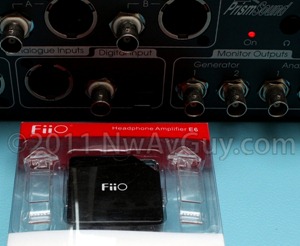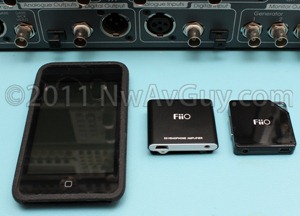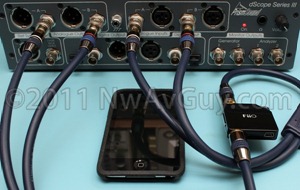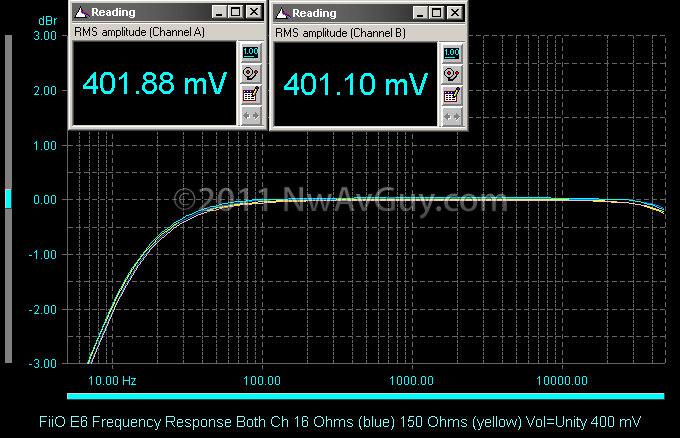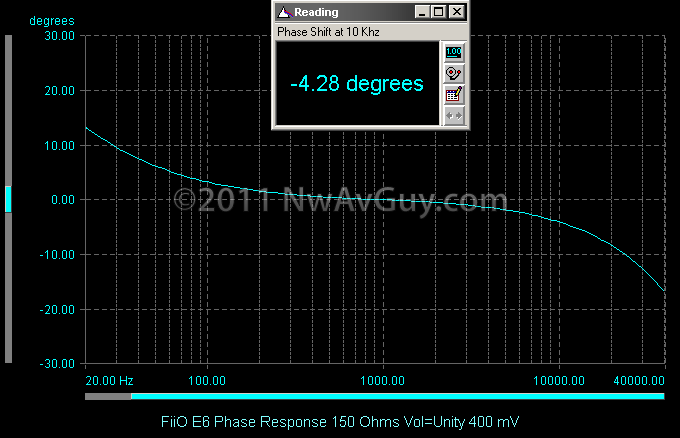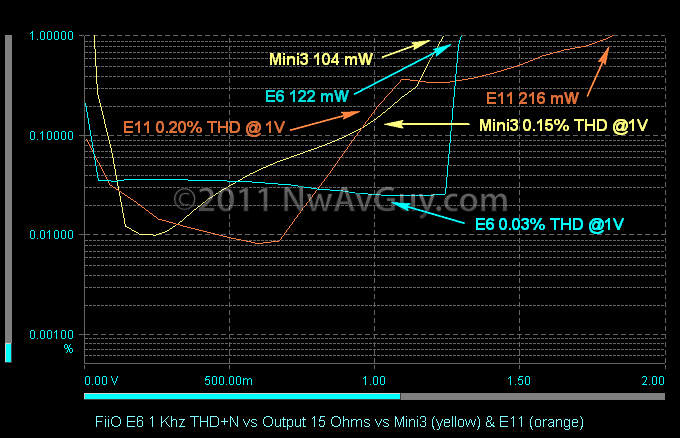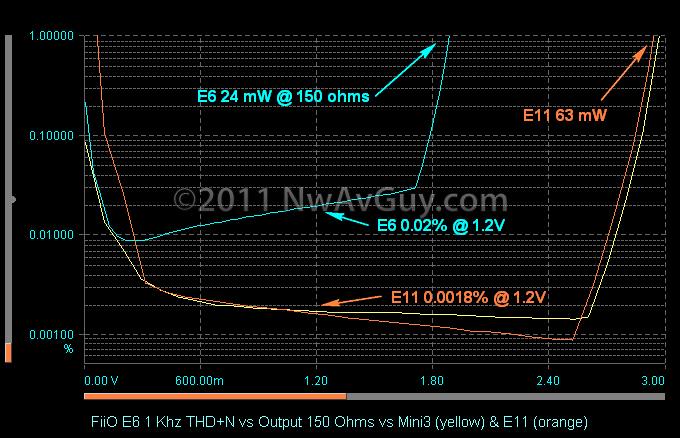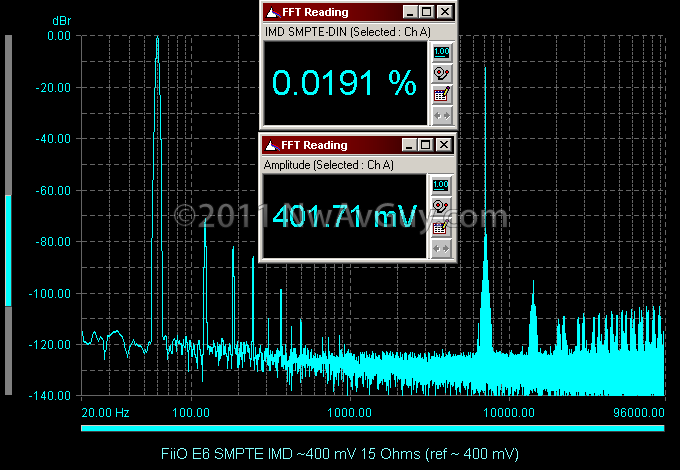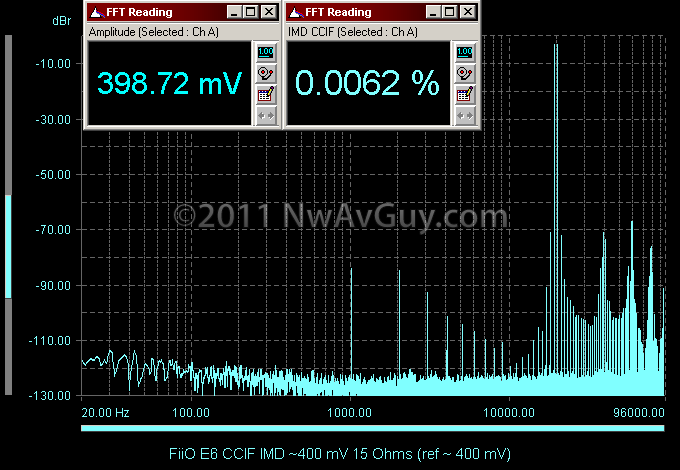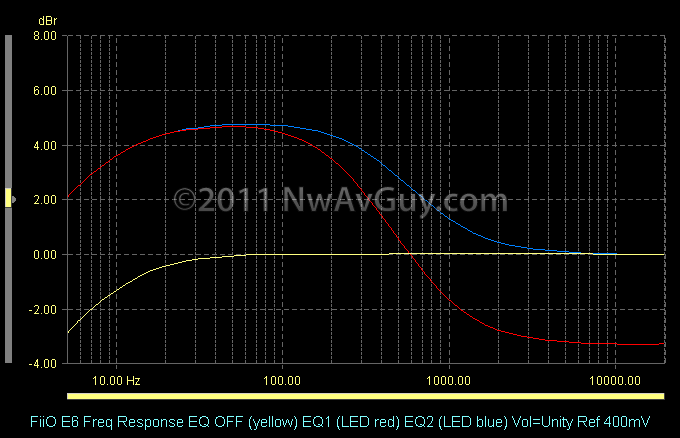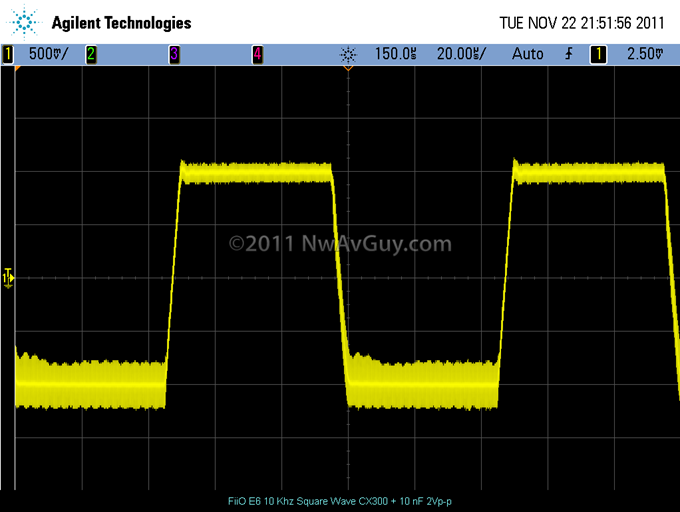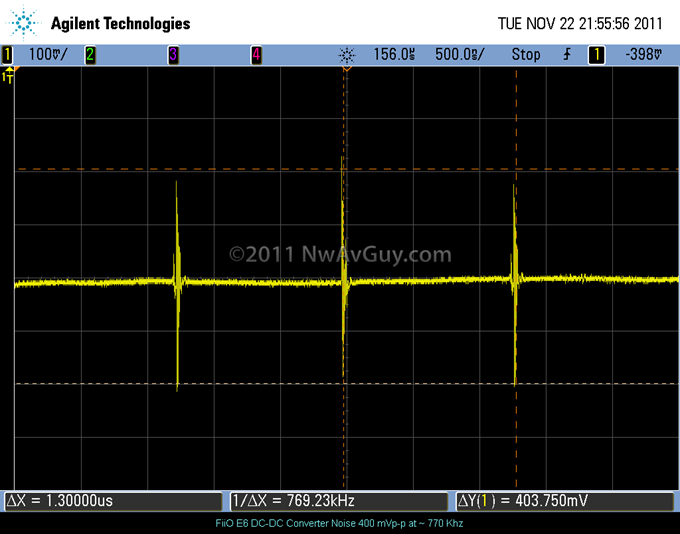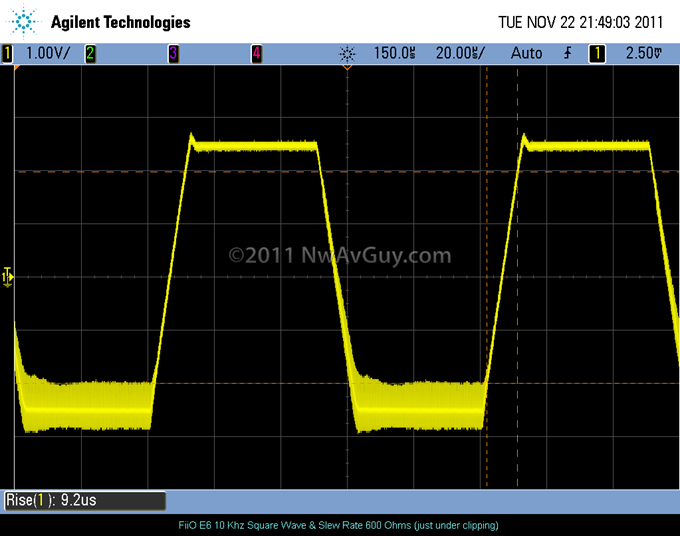 INTRO: Given the FiiO E11 is almost a direct clone of the AMB Mini3 I wasn’t sure it was worth my time to review it. The Mini3 has some significant problems mainly related to its 3 channel channel design. Using a similar 3 channel approach FiiO seemingly copied the Titanic complete with the big hole. But I’ve had many requests to test the E11 (and the similarly amplified but still missing-in-action E10). Plus the E11 has some significant improvements over the Mini3 including longer battery life, USB charging, two gain modes, a three position EQ switch, smaller size, lighter weight, and a much lower price of around $65 vs $150+ for an assembled Mini3. If it’s a decent amp, the E11 would neatly fill the price gap between something like the FiiO E6 and the O2 portable amp. So I gave in and decided to review it after all.
INTRO: Given the FiiO E11 is almost a direct clone of the AMB Mini3 I wasn’t sure it was worth my time to review it. The Mini3 has some significant problems mainly related to its 3 channel channel design. Using a similar 3 channel approach FiiO seemingly copied the Titanic complete with the big hole. But I’ve had many requests to test the E11 (and the similarly amplified but still missing-in-action E10). Plus the E11 has some significant improvements over the Mini3 including longer battery life, USB charging, two gain modes, a three position EQ switch, smaller size, lighter weight, and a much lower price of around $65 vs $150+ for an assembled Mini3. If it’s a decent amp, the E11 would neatly fill the price gap between something like the FiiO E6 and the O2 portable amp. So I gave in and decided to review it after all.
THE FiiO E11: The E11 was so light when I first held it I wondered if the battery was installed. It doesn’t have nearly the heft and solid feel of the FiiO E7. It turns out the battery was installed and the E11 is a feathery 2.3 ounces (65g)--less than half the weight of the current iPhone. If you’re going to carry the E11 in your pocket, or “rubber band” it to your iPod (it comes with a heavy rubber band), the light weight is a good thing. FiiO even protected the volume control making the E11 more “pocket friendly” helping prevent accidental volume changes. It has 3.5mm input and output jacks and a volume control that also serves as the power switch. Going beyond the Mini3, the E11 adds a mini USB port for charging, a two position gain switch, a three position EQ switch, and the battery can be swapped out without needing a screwdriver (for now at least you can get extra batteries but 2 or 3 years from now don’t count on it). It’s also smaller and thinner than the Mini3. The USB port is especially handy although it doesn’t come with a charger so you need a PC, laptop, USB charger, iPhone/iPod/iPad charger, etc. For traveling it’s one less thing you have to bring along but there’s a huge catch…
DESIGN FLAW #1 – NO DESKTOP OPERATION: Sadly the E11 cannot operate while external power is connected via the USB jack. That means it’s impossible to use it as a regular desktop amp as the battery will end up dead and you can’t listen to it while it’s charging. Ironically this might be another downside to the 3 channel virtual ground which puts the E11’s audio ground at about 4.5 volts DC while the PC’s USB ground is at 0 volts—connecting the two with the amp operating would short it out and possibly damage it. For a lot of people this is a significant limitation. For those using it at home, it also means a lot more wear and tear on the battery shortening its life. In my opinion, this makes the E11 mainly suitable only for those who want an amp to use only on the go and not at home or the office.
DESIGN FLAW #2 - THREE CHANNEL DESIGN: FiiO not only chose a similar 3 channel design but they even used the Mini3’s problematic OPA690 op amp (which isn’t even designed for audio use) for the third channel. And, incredibly, they even copied one of AMB’s false claims for the Mini3. FiiO’s website claims: “Heavy current three channels amplified circuit, effective to lower the output impedance.” In reality, using three channels raises the output impedance. Even Ti Kan at AMB has admitted as much in forum posts. This point is discussed extensively in my Virtual Grounds & 3 Channel Amps article as well as the original Mini3 review. Apparently FiiO, a Chinese company, either copied the Mini3 design without understanding its flaws (or reading my related blog articles), or they have joined forces with AMB in knowingly promoting misleading statements about 3 channel designs. The “lower output impedance” is pure myth, or purely misleading, depending on your point of view. But, in my opinion, it doesn’t reflect well on FiiO as a company.
TWO POWER RANGES: There’s a switch under the battery labeled “High Power” and “Low Power”. I did all my testing at “High Power”. FiiO lists two power specs at three impedances and they’re all 4 dB apart in the two modes. I believe the idea is to extend battery life by lowering the power supply voltage for headphones that don’t need the full output. It’s a useful feature if you plan to use it with sensitive headphones.
SUBJECTIVE LISTENING: I listened to the E11 with several headphones. It had enough output, barely, for my HD650s listening to classical music at live levels. Unlike many amps, such as the FiiO E9, the E11 sounded reasonably good with my Ultimate Ears SuperFi 5’s, but there was some hiss audible with nothing playing. Besides the hiss, I didn’t hear anything that was offensive but I didn’t spend a lot of time listening either.
BASS EQ: With some headphones, like my Etymotic ER-4 IEMs, the bass EQ was useful. On bass shy music the “2” (maximum) setting added some heft and on more normal music the “1” setting was more appropriate. But with headphones that already lean towards “boomy”, which sadly includes most of them, the EQ options just added to the boom and/or muddy bass. So it will depend on your headphones, music, and tastes, if you like the bass EQ. My personal preference is for deeper bass boost but I’ve heard worse EQ than the E11’s.
GAIN: The gains are 2.5X and 4.5X. The first is appropriate for a low gain setting, but 4.5X is on the low side for a high gain option. This is especially true for a battery-only portable amp like the E11 that’s much more likely to be used with low output portable players. Using the line out (LOD) on an iPod, or the headphone out on a Sansa Clip+, you can’t drive the E11 to full output into high impedance headphones even at the high gain setting. That’s a significant limitation for owners of headphones like the HD600/650, DT880, etc. See the Tech Section for the details. For more see: All About Gain
BATTERY LIFE: I didn’t test the battery life. FiiO rates it at 10 hours which is roughly double the real world run time of the Mini3 and slightly better than the higher output O2. It’s not clear if this is with the power switch set to the “High” or “Low” position but I’m guessing the 10 hours is at the Low Power setting.
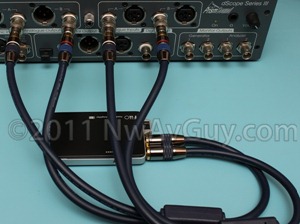 MEASUREMENT SUMMARY: Most of the E11’s measurements are decent enough—especially for a $65 amp. The E11 gets the basics right. It has flat frequency response, a very low output impedance, is reasonably quiet, and has mostly low distortion. There are, however, some problem areas. The E11 has very odd overload/clipping behavior into 32 ohm and lower impedance loads and a bit more low frequency phase shift than is ideal. Even being generous, it fell far short of several of its claimed power measurements. It also suffers from some of the Mini3’s potentially audible Interchannel IMD distortion due to the three channel design. And it shares the Mini3’s marginal stability but, unlike the Mini3, it’s only significant with more challenging loads. There’s some RF leakage of the DC-DC converter into the audio output (but it’s much better than the E5 and E7). Despite all these issues, the E11 still substantially outperforms the Mini3 using the same op amps and a very similar design. This is yet another example of the devil being in the details. FiiO simply did a better job with the implementation than AMB did using the same parts. For example it seems FiiO chose to use a single ground in the E11 which likely helped many of the measurements compared to the Mini3’s split ground and poor ground routing. See the Tech Section and my article on Virtual Grounds for more details. The following table compares the E11 to the O2, FiiO E9 and AMB Mini3:
MEASUREMENT SUMMARY: Most of the E11’s measurements are decent enough—especially for a $65 amp. The E11 gets the basics right. It has flat frequency response, a very low output impedance, is reasonably quiet, and has mostly low distortion. There are, however, some problem areas. The E11 has very odd overload/clipping behavior into 32 ohm and lower impedance loads and a bit more low frequency phase shift than is ideal. Even being generous, it fell far short of several of its claimed power measurements. It also suffers from some of the Mini3’s potentially audible Interchannel IMD distortion due to the three channel design. And it shares the Mini3’s marginal stability but, unlike the Mini3, it’s only significant with more challenging loads. There’s some RF leakage of the DC-DC converter into the audio output (but it’s much better than the E5 and E7). Despite all these issues, the E11 still substantially outperforms the Mini3 using the same op amps and a very similar design. This is yet another example of the devil being in the details. FiiO simply did a better job with the implementation than AMB did using the same parts. For example it seems FiiO chose to use a single ground in the E11 which likely helped many of the measurements compared to the Mini3’s split ground and poor ground routing. See the Tech Section and my article on Virtual Grounds for more details. The following table compares the E11 to the O2, FiiO E9 and AMB Mini3:
.
| Measurement | FiiO E11 | O2 | FiiO E9 | AMB Mini3 |
| Frequency Response | +/- 0.1 dB A | +/- 0.1 dB A | +/- 0.1 dB A | +/- 0.1 dB A |
| THD 1 Khz 150 Ohms | 0.004% A | 0.0016% A | 0.005% A | 0.002% A |
| THD 1 Khz 15 Ohms | 0.011% B | 0.0023% A | 0.037% C | 0.017% B |
| THD 20 hz 15 Ohms | 0.017% B | 0.0023% A | 0.05% Good | 0.01% B |
| THD 20 Khz 15 Ohms | 0.011% B | 0.010% A | 0.003% A | 0.45% F |
| IMD CCIF 15 Ohms | 0.002% A | 0.001% A | 0.05% C | 0.043% D |
| IMD SMPTE | 0.0079% A | 0.002% A | 0.002% A | 0.009% B |
| Noise A-Wtd | -101.3 dBu B | -114 dBu A | -94.7 dBu C | -103.2 dBu B |
| Max Output 15 Ohms | 63 mW B | 337 mW A | 1067 mW A | 104 mW A |
| Max Output 33 Ohms | 101 mW C | 613 mW A | 883 mW A | 98 mW C |
| Max Output 150 Ohms | 52 mW C | 355 mW A | 317 mW A | 38 mW C |
| Output Impedance | 0.5 Ohms A | 0.54 Ohms A | 10 Ohms C | 0.9 Ohms A |
| Crosstalk 15 Ohms | 48 dB B | 65 dB A | 63 dB A | 40 dB C |
| Channel Balance | 1.1 dB B | 0.6 dB A | 1.8 dB C | 1.14 dB B |
| Battery Life | ~10 hours | ~8 hrs / ~30 hrs | AC Only | ~5 hours |
FIRST CLASS:
- Small and light
- Relatively low noise
- Flat frequency response
- Low output impedance
- Significantly improved performance over Mini3
- Two gain options
- USB battery charging
ECONOMY:
- Cannot use the amp on external power (can only run from the battery)
- Even the high gain setting limits output with iPod LOD input
- Fails to meet published power specs at 1% THD both channels driven
- Third channel creates some interchannel distortion and degrades performance
- Some moderate low frequency phase shift
- Shows signs of instability with difficult loads
- Odd clipping behavior into 15 and 33 ohms implies power supply limitations
- Significant RF leakage from DC-DC converter into output
HEADPHONE COMPATIBILITY: For most headphones with high sensitivity the E11 should be OK. The output impedance is low enough for even balanced armature IEMs. But it’s marginal for headphones like the popular Sennheiser HD600 and HD650 which require at least about 2.5 Vrms to avoid clipping the peaks of dynamic music at typical loud listening levels. But that’s partly dependent on the type of music and how loud a person wants to listen. Forget the popular Beyer DT880-600, Audeze LCD-2, HiFiMan planars, etc. and headphones like the AKG K701/K702 will be marginal. The E11 doesn’t have enough output voltage for any of them. See my More Power article for more details on determining what headphones will work well with the E11.
BOTTOM LINE: The E11 performed better than I was expecting given it’s a virtual clone of the Mini3 and much less expensive. It’s biggest weakness for many will be only operating off battery power with the amp being unusable while charging. That makes it a very poor choice for home or office use. Many might find the adjustable gain useful although some may be left wanting for more gain—especially using an iPod LOD as the source with voltage hungry headphones. The E11 has a bit more output into high impedance loads, at least when fully charged, making it a better match for the popular Sennheiser HD600/650 and similar headphones but only if your source can produce at least 650 mV (many portables max out at 500 mV). If you don’t mind running it only from battery, and it has enough output for your headphones, the E11 is a reasonable choice—especially if you’re on a tight budget and want a highly portable amp. Despite its several flaws it’s still a significant upgrade from the FiiO E5 and E6. If you want lower noise, lower distortion, customizable gain, and much higher output to drive nearly any headphones, the O2 portable amp is a significant upgrade but it’s larger, heavier and more expensive.
TECH SECTION:
HARDWARE: The E11 uses the same AD8397 op amp design as the Mini3. The AD8397 has the advantage of high current output but it’s also rather “high strung” and, in the Mini3, it runs “wide open” (with no stability compensation) on the edge of being unstable. The E11 also uses the same OPA690 op amp for the third channel virtual ground as the Mini3 which is a poor choice. It has relatively low PSRR and isn’t even specified for operation at audio frequencies. This is discussed more in the Mini3 review. The Mini3 runs from a single 8.4V NiMh rechargeable battery with the OPA690 referenced to half that creating a “virtual” bipolar +/- 4.2V power supply for the AD8397. In comparison, the E11 uses a single 3.7V li-Ion battery and a DC-DC converter stepping it up to a higher single voltage around 9 volts which is then artificially split into +/- 4.5 volts. This puts the audio ground at 4.5 volts DC which is probably why you can’t use the amp and charge it at the same time. Connecting the audio ground to your PC’s ground would short out the E11’s OPA690 and power supply if it’s not an isolated DC-DC converter.
E11 DESIGN FLAW: If you’re going to bother with a DC-DC converter, it’s not much more expensive or difficult to have a bipolar DC-DC converter that generates a true positive and negative power supply with a real ground. Such a converter would have eliminated the need for the OPA690 entirely along with it’s rather hungry power consumption, added distortion, added output impedance, added crosstalk, and limited current capability. The extra expense in the DC-DC converter is probably less than the cost of the OPA690. In short, FiiO missed the opportunity to make the E11 a better headphone amp without increasing the component costs.
ISOLATED DC-DC CONVERTER: FiiO could have used true bipolar regulated DC-DC converter with at least the negative rail being isolated from ground. That would eliminate all the third channel problems, increase run time (getting rid of the hungry OPA690), maintain the power output as the battery voltage drops, and best of all, allow using it as a desktop amp. With such a power supply the E11 also could have been used during charging making it much more suitable as a desktop amp.
WHY THE FLAW? FiiO’s choice is difficult to understand unless they were simply bent on completely copying the Mini3 and/or believed AMB’s highly misleading claims for 3 channel designs. I suspect they were just trying to seize on the Mini3’s popularity by copying it as closely as possible. But, like the Titanic referenced earlier, the Mini3’s popularity seems to be fading fast with its real performance revealed. Many have reported difficulty selling their Mini3 for a reasonable price since my review came out. See Virtual Grounds & 3 Channel Amps and the original Mini3 review for more.
FREQUENCY RESPONSE: Much like the O2, the E11 has some minor low frequency roll off. Unlike the fully direct coupled Mini3, FiiO wisely chose to add a DC blocking capacitor to the signal path. That way the E11 won’t amplify any DC present on the input. It may however, given the E11’s size and price, be an electrolytic capacitor which can degrade the audio performance. The high frequency performance was very flat and extended. The second graph shows the Mini3 for comparison into 15 and 150 ohms and the O2 comes in somewhere between two:

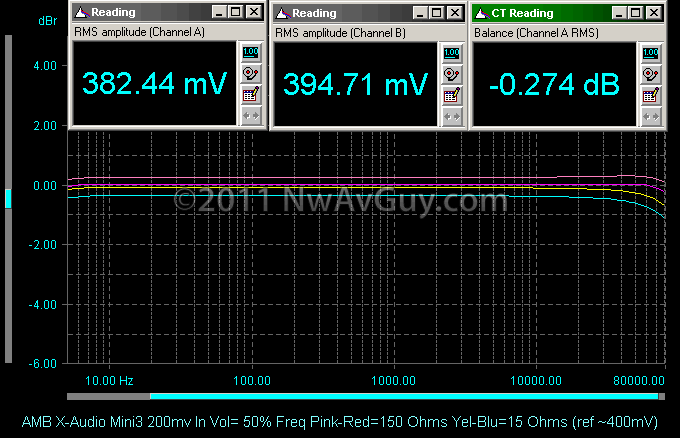
PHASE ERROR: The E11’s low frequency roll off created some phase error that hits about 15 degrees at 20 hz. The goal is less than 1 degree of error from 100 hz to 10 Khz where the ear is most sensitive. The E11 manages at the high end but fails at the low end with about 4 degrees of error at 100 hz. The weird kink close to 20 hz is because the settling time was set too short on the dScope—it’s a test artifact not the E11. The second graph shows the O2 which has DC blocking and stability compensation but still manages to stay under 1 degree of error over the desired range. The Mini3’s phase response is even flatter but that’s because it lacks desirable DC blocking and high frequency compensation. The slight droop above 10 Khz is evidence FiiO wisely chose to either add compensation to the AD8397 and/or included an RF blocking filter at the input:
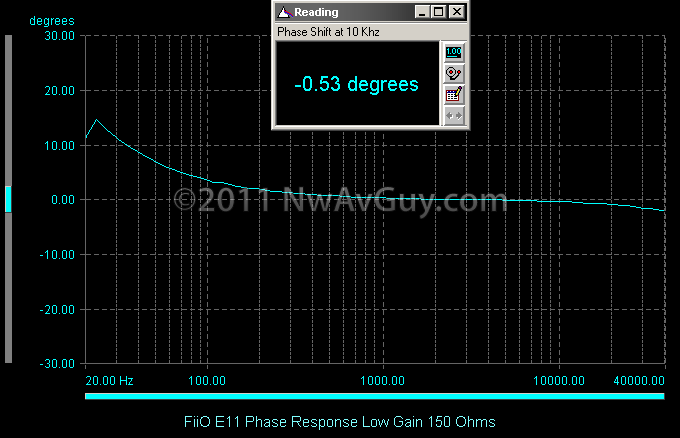
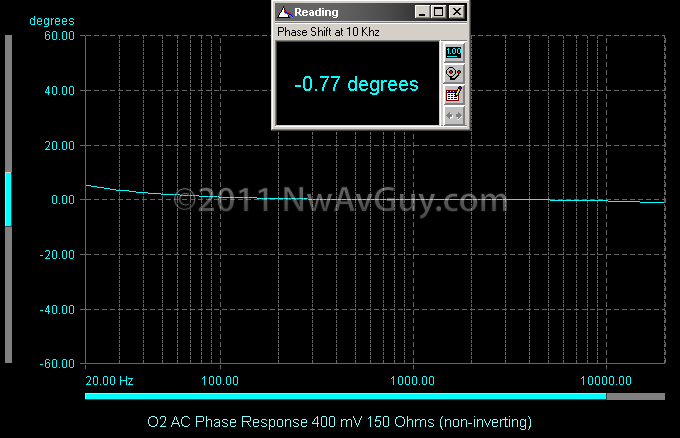
1 Khz THD+N vs OUTPUT: The E11 has similar distortion to the Mini3 into 80+ ohms but with significantly higher maximum output. The E11 produced 2.7 Vrms into 80 ohms while the Mini3 could only manage 2.4 Vrms into an even easier 150 ohms. The E11 produced 2.95 Vrms into 600 ohms or 14.5 mW where the Mini3 could only manage 2.45Vrms or 10.0 mW. This gives the E11 a noticeable 1.6 dB advantage. Into 33 ohms and lower, the E11 exhibits rather odd distortion characteristics at higher outputs. Into 15 ohms (white plot) it has much lower distortion than the Mini3 up to about 800 mV then the distortion rises sharply but stops rising around 1 volt and levels off around 0.3% before finally hitting the official 1% at 1.9Vrms—much better than the Mini3’s 1.25 Vrms into the same load. But, to be fair, I would call the real “clipping point” of the E11 around 1 volt. It exhibits similar behavior into 33 ohms as seen in the green plot. My best guess is the DC-DC converter power supply in the E11 is current limiting and/or the power supply capacitors are undersized and there is excessive power supply ripple at higher output currents. The relatively poor PSRR of the OPA690 would pass a significant amount of the ripple to the audio output creating greatly increased THD+N. The second graph shows the Mini3 for comparison into 15 and 150 ohms. While it’s not shown, the E11 produced 2.85 Vrms into 150 ohms at 1% THD vs 2.4 Vrms for the Mini3 with the same load. The third graph shows the much higher output and overall lower distortion of the O2 into all loads. In summary, the E11 produces 63, 101, 91, 52 and 15 mW into 16, 32, 80, 150 and 600 ohms respectively:
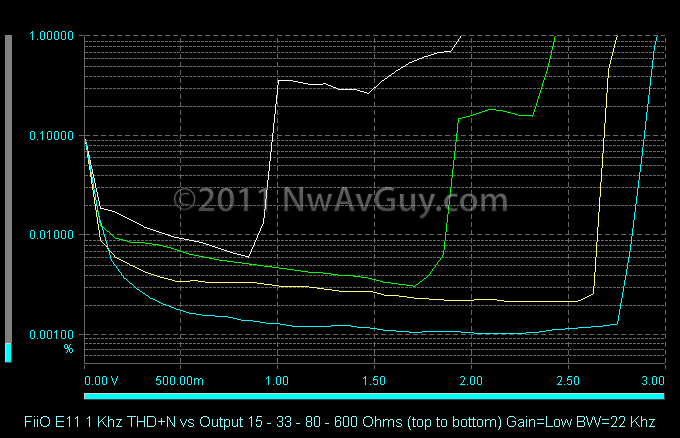
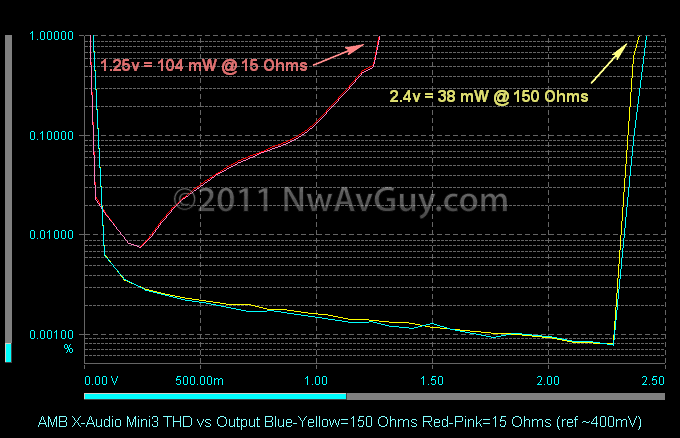

CLAIMED OUTPUT vs ACTUAL OUTPUT: FiiO Claims 300 mW into 16 ohms fully charged. Using 1 volt as the clipping point, the E11 only delivers 62 mW and even using the 1.9V value it still falls short at 225 mW. It’s also interesting 300 mW is exactly the same number AMB quotes for the Mini3 and it also falls far short. In all cases, taking the higher of the clipping points the amp at least exceeded the low number provided by FiiO but it should have been much closer to the high number. I suspect, like perhaps AMB, FiiO was somewhat cheating here and probably had the battery at an unrealistically high voltage and was only driving one channel. The gain switch made no difference in these measurements. Here are all the numbers with about 15 minutes of light average use on a fully charged battery in the High Power mode:
- 16 Ohms FiiO claims 300/120 mW (High/Low power) but it only delivers 63 mW (225 mW at 1%)
- 32 Ohms FiiO claims 200/88 mW but it only delivers 101 mW (180 mW at 1%)
- 300 Ohms FiiO claims 35/13 mW but it only delivers 26 mW at 1%
100hz OUTPUT IMPEDANCE & MAX POWER: Since the Mini3 review back in May, I’ve revised my impedance measurements to use 100 hz instead of 1 Khz to more closely reflect the resonance impedance of headphones where electrical damping is most needed. At 100 hz the E11 gets close to 1% THD somewhat earlier than the 1.9 Vrms seen in the earlier graph at 1 Khz (1.62 Vrms). Removing the load resulted in the output rising only slightly to 1.66 Vrms. This works out to an output impedance of 0.5 ohms. The Mini3 measured a higher but similar 0.9 ohms at 1 Khz. Both are “good enough” but I have to wonder if FiiO chose to use a single ground for the entire amplifier vs splitting the input and output grounds like AMB chose to do. That would allow the amplifier to partially correct for some ground impedance via feedback and would explain the lower output impedance. It’s also worth noting while the E11 matches the O2 at 0.5 ohms, in the O2 thee output isolation resistor dominate that value, the actual output impedance of the amp is much lower. In the E11, however, it’s the OPA690 virtual ground channel likely dominating the measurement:
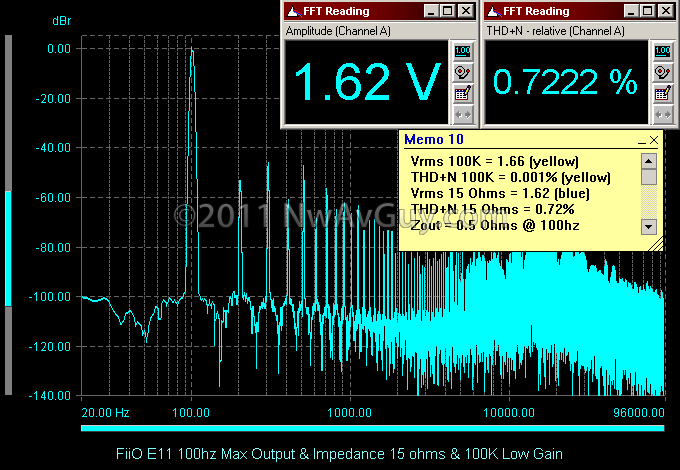
THD+N vs FREQUENCY: Here’s the THD+N vs frequency at the same 400 mV I tested the Mini3 at. Into 600 ohms it’s respectably low around 0.003%. Into 33 ohms it’s still under 0.01%. Into 15 ohms it approaches 0.02% which is acceptable but not ideal as there are distortion products above –80 dB. The rise at low frequencies might be due to power supply capacitors that are too small. Just like the Mini3, the E11 isn’t very happy into low impedance loads. And, like the Mini3, this picture gets worse at higher output levels. I didn’t run this exact test on the Mini3 but I did measure 400 mV THD+N at fixed points of 20hz, 1 Khz and 20 Khz where the distortion was 0.01%, 0.016%, and a very high 0.45%, respectively into the same 15 ohms. The E11 performs very similarly to the Mini3 at low and mid frequencies and much better at high frequencies. The second graph shows the much lower distortion of the O2 for comparison into 33 and 150 ohms:


SMPTE IMD 15 OHMS: I tested the E11’s SMPTE IMD at 400 mV which is generally my current standard. It had acceptably low distortion with everything below –80 dB. The Mini3 performed poorly at 400 mV into 15 ohms so it was tested at only 200 mV, and even at half the output, had slightly higher but similar IMD. The second graph shows the Mini3 at 200 mV. The third graph shows the O2 under exactly the same conditions as the E11. Note the O2’s distortion reading is over 7 times lower and how much smaller the “mountain” around the base of the 7 Khz signal is. Note also the relative lack of distortion products above 7 Khz on the O2:

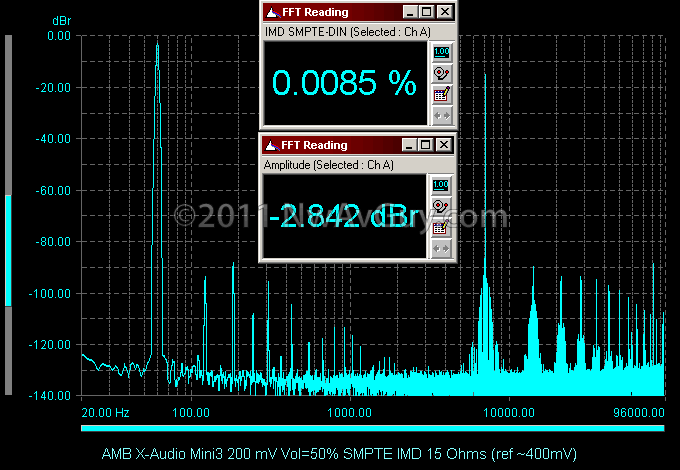
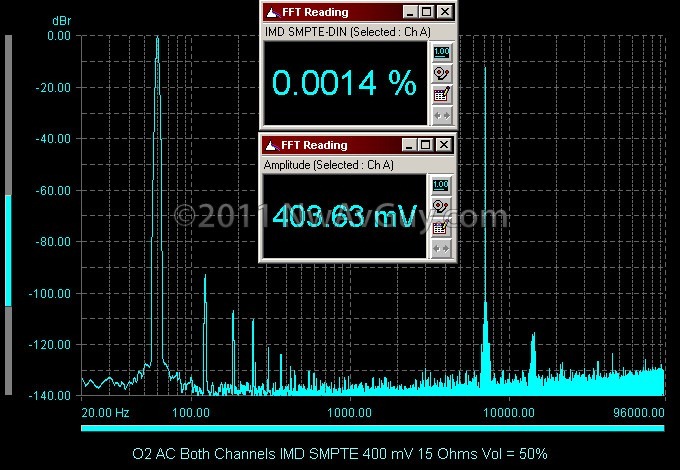
CCIF IMD 15 OHMS: The E11 also does respectably well on the CCIF IMD test with everything below 80 dB. This is a much better performance than the Mini3 which had 18 times more distortion on the exact same test. The E11 has everything below –90 dB in the audio band while the Mini3 had distortion products up to a likely audible –52 dB. Considering both amps use the same op amps this is a classic example of implementation is everything. Just using high-end parts doesn’t assure high-end performance. FiiO apparently did a much better job with the PC board layout, ground scheme, stability compensation, etc. The result is 18 times less high frequency distortion from the same parts. The O2 is shown in the third graph with about half the overall IMD of the E11 on the same test: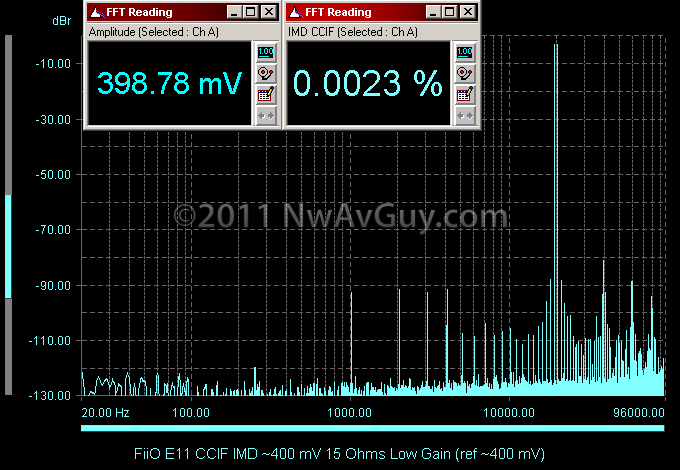
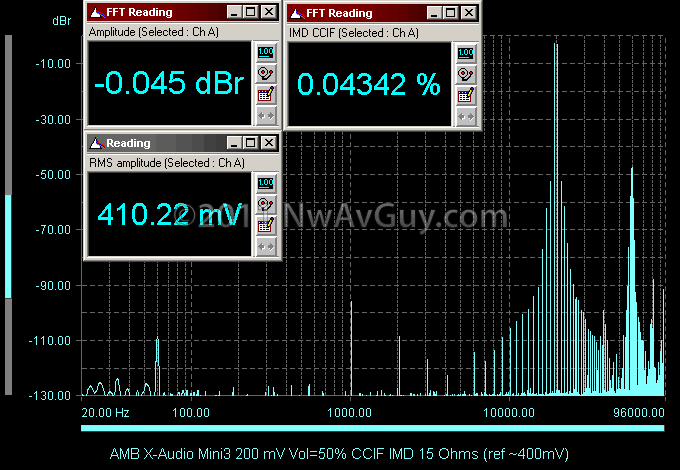
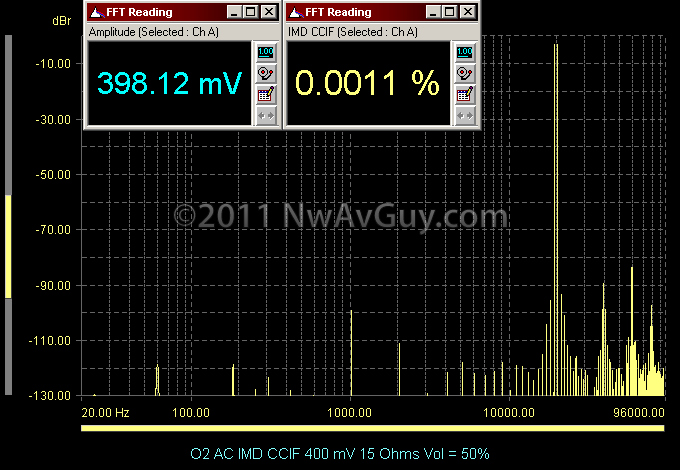
NOISE: The E11 had respectable noise levels of –101.3 dBu A-Weighted and 13.5 uV of raw noise at full volume on the low gain setting. Using high gain added a few dB more noise. The readings were similar at 50% volume. The industry standard dBu reference is 775 mV. The Mini3 noise measurement was referenced to 400 mV. To convert it’s 20*LOG(775/400) = +5.7 dB. So the Mini3’s A-Weighted noise in the second graph is 97.5 dBr + 5.7 dB = 103.2 dBu or about 2 dB better than the E11. I suspect the Mini3 does slightly better because of the lack of a noise producing DC-DC converter. It’s also possible the EQ circuitry in the E11 contributes some noise even when it’s set to “flat”. It could also be due to the Johnson noise of the resistors. Overall, for a cheap amp with a DC-DC converter, the E11 is impressively quiet. The O2 noise is shown in the third graph in dBv referenced to 1 volt. To convert to dBu it’s –2.2 dB giving 116.2 – 2.2 = 114 dBu. So, in summary the E11, Mini3 and O2 are 101.3, 103.2, and 114 dBu respectively A-Weighted. The E11 and Mini3 are similar while the O2 has much lower noise:
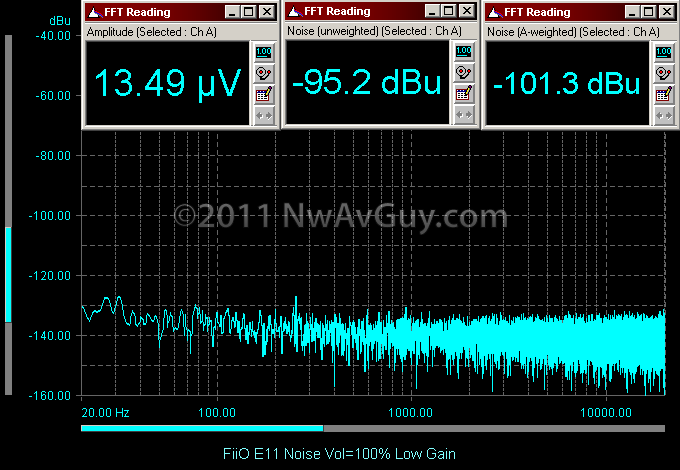
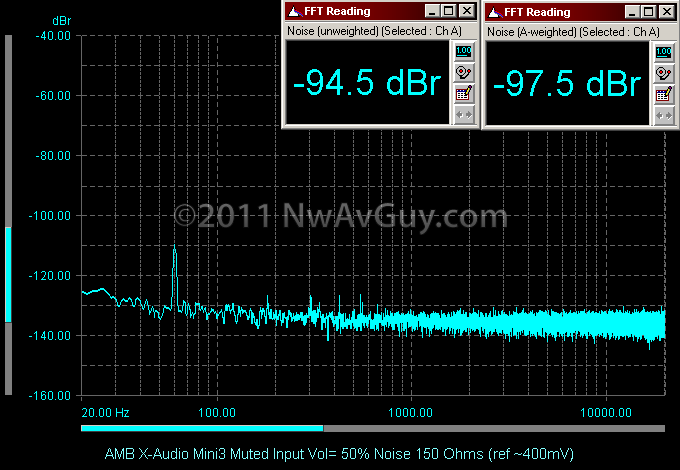
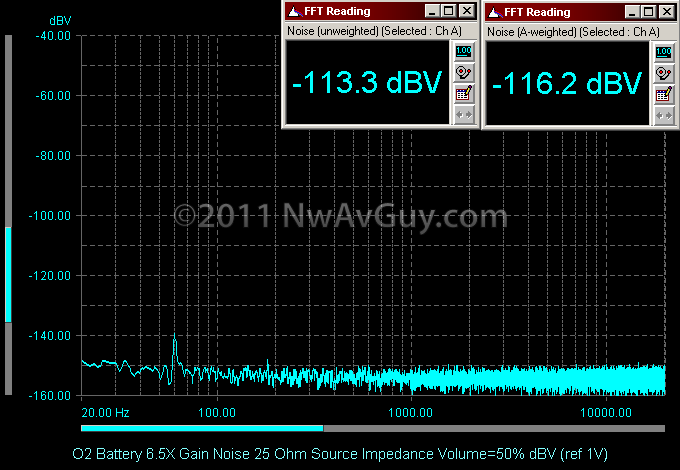
CROSSTALK: The E11 had crosstalk of 53.6 dB into 33 ohms and 48 dB into 15 ohms. For comparison, the Mini3 measured 46 dB and 40 dB into 33 and 15 ohms respectively. The second graph shows the Mini3 into 15 ohms and 150 ohms. Into 600 ohms the E11 was better than 80 dB up to about 1500 hz and rising from there mostly due to coupling in the volume control. I suspect the E11 does nearly 8 dB better than the Mini3 because the ground system isn’t split between the input and output like it is on the Mini3. Ti Kan claims this improves performance, but as seen here and with the E11’s lower output impedance earlier, it actually degrades performance as it removes the ability of the op amp's to correct for ground signals. And even with an improved third channel ground scheme, the E11 is still far inferior to the O2 shown in the third graph. Into the same 33 ohms the O2 managed 65 dB vs 53.6 dB for the E11:
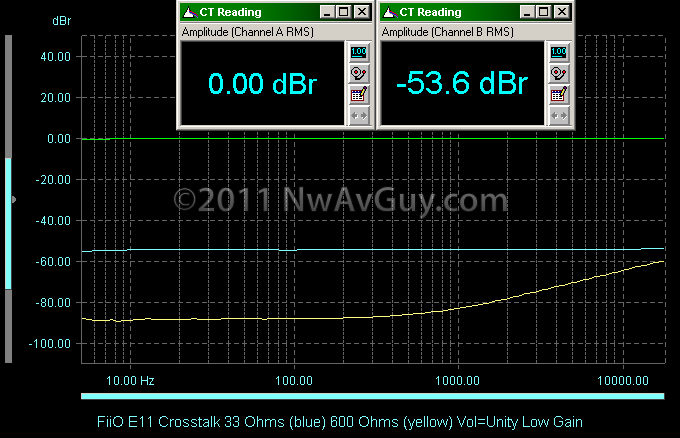


INTERCHANNEL IMD BASELINE: The most likely audible flaw of the Mini3 is Interchannel IMD. Because the two channels interact with a common third channel (the OPA690 virtual ground amp) they share any distortion produced by the OPA690 and in the ground system in general. This is a potentially highly audible form of distortion because the distortion products are not directly related to what’s playing in that channel. The Mini3 splits the internal grounds removing the ability of the op amps to correct for certain kinds of ground signals. I measure Interchannel IMD by first showing the THD spectrum for just one channel operating at 1 volt into 15 ohms. This establishes a baseline for distortion related to just that channel and signal. The E11 produced a very respectable 0.005% THD+N figure with all the distortion products below the desired –80 dB threshold. This about 6 times better than the Mini3 managed which hit 0.03% THD+N and –62 dB as seen in the second graph. The third graph shows the O2 same signal, same load with even lower distortion than the E11:
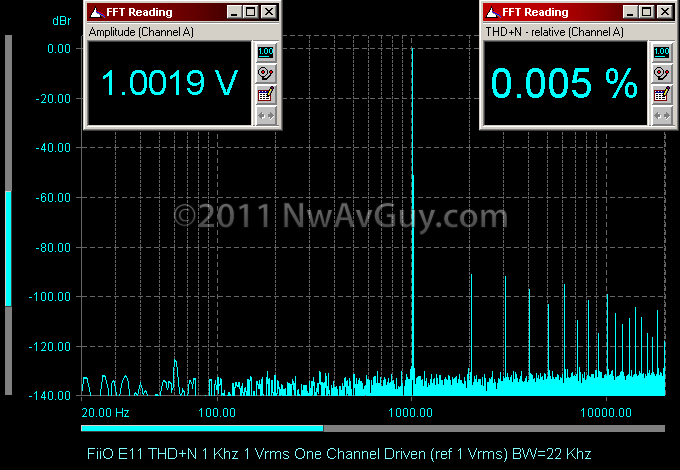
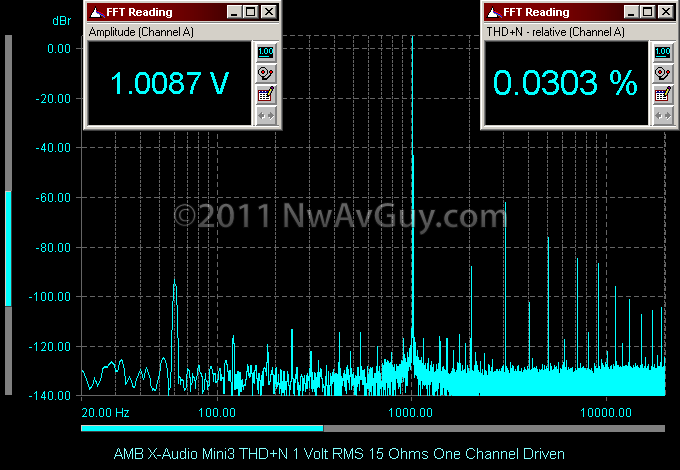
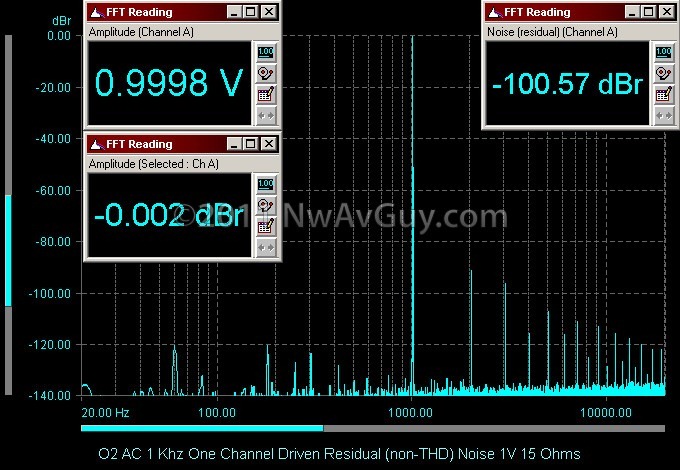
INTERCHANNEL IMD 1 Khz & 300 hz: This is where things get interesting. Nothing changes with the channel shown above, but now the other channel is also driven to 1 volt but at 300 hz. This creates peak currents that are still within the OPA690’s specifications so it should not be overloading any part of the E11 or Mini3. Ideally one would just see a component at 300 hz at the level of crosstalk present in the amplifier. This isn’t distortion it’s linear (i.e. relatively pleasant sounding) crosstalk. But any other significant new distortion products are cause for concern. The E11 shows the expected crosstalk at 300 hz while everything else is still below about –90 dB but there’s a new “forest” of IMD products visible in the spectrum that were not present in the baseline graph above. Each spike is summed or added together to form the total amount of distortion—something I would have to write a custom script to get the dScope to calculate while leaving out the 300 hz crosstalk. In short, this is still a potentially audible amount of distortion due to the shear number of distortion products. The second graph shows the much worst result from the Mini3 where there are several distortion products above the –80 dB threshold and very likely sum to an easily audible value. See Virtual Grounds & 3 Channel Amps and the original Mini3 review for more. The third graph shows the vastly better result from using a real ground in the O2’s conventional 2 channel design. Notice the “forest” is gone in the O2 graph with mainly just the expected signal-related harmonics of the 1 Khz signal visible:
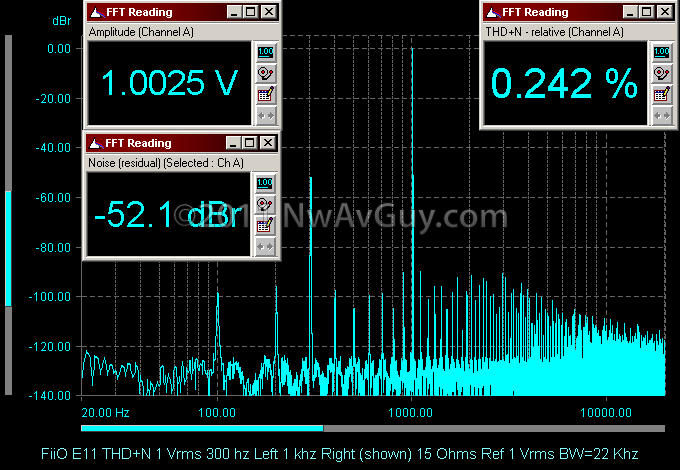
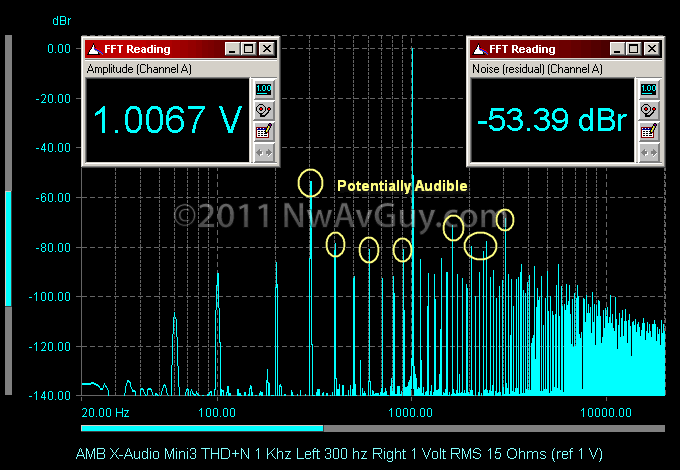

CHANNEL BALANCE: For a relatively inexpensive amp, the E11 had decent channel balance being just slightly over the goal of 1 dB at -45 dB. You can also see from the gap between the blue lines there was also about 1 dB of error at –22 dB. This is similar to the Mini3’s worst case error of –1.1 dB at –28 dB. The O2 was better with a worst case error of 0.6 dB at –55 dB:

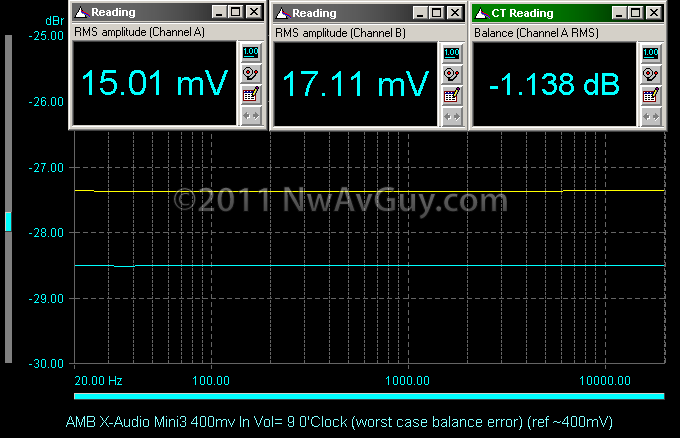
GAIN: At the low gain setting the E11 measured 8.2 dB (2.5X) of gain (no EQ) as can be seen below with 387 mV input and 1 volt of output. This is identical to the O2’s default low gain setting. The second graph shows the high gain setting at 12.9 dB (~4.5X). This means, at high gain, with 500 mV of input from an iPod LOD (line output), and many portable players, you’ll get 2.25 Vrms out. This is well shy of the 2.9 Vrms the E11 is capable of and may not be loud enough for many headphones like the HD600/650. For comparison, the O2 has 16 dB (6.5X) of default gain at the high setting, and the default fixed gain of the Mini3 is about 14 dB (5X). These graphs also show respectably low distortion at 1 volt output into 150 ohms. For more see: All About Gain
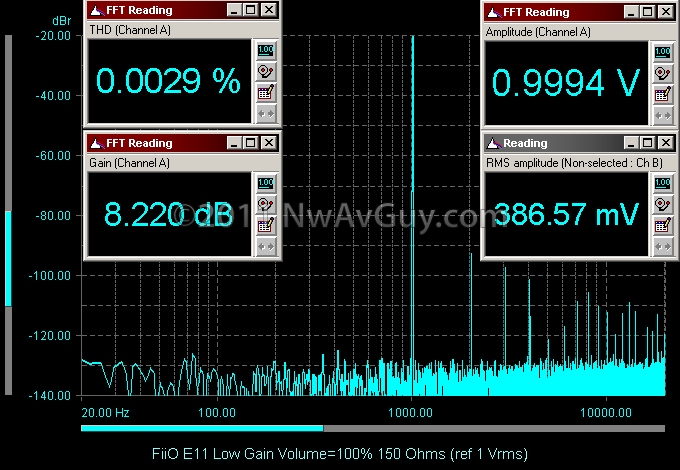
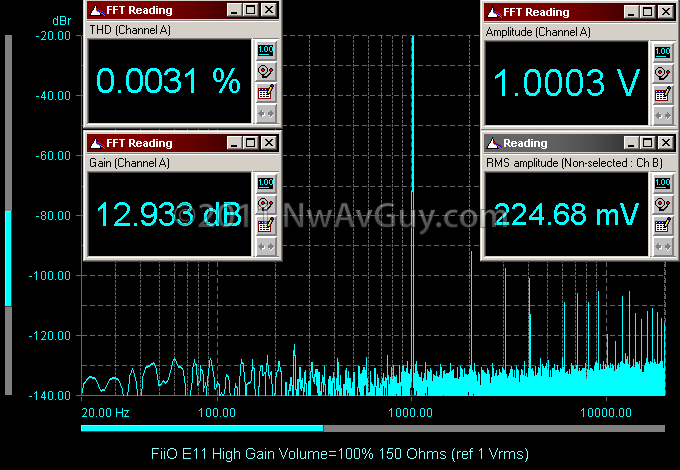
EQ: Here’s the frequency response with the EQ switch set to “0” (EQ off yellow), “1” (white) and “2” (blue). Both EQ options create a peak centered at about 50 hz with a 3.5 dB maximum boost on setting “1” and a 6.8 dB peak on “2”. both EQ options also raise the overall volume about about 0.6 dB at all frequencies. There is significant boost above 80 hz which may result in some “boomy” bass with many headphones. I personally prefer bass boost down lower that’s mostly nil by 80 hz but some may still find the E11’s options useful:
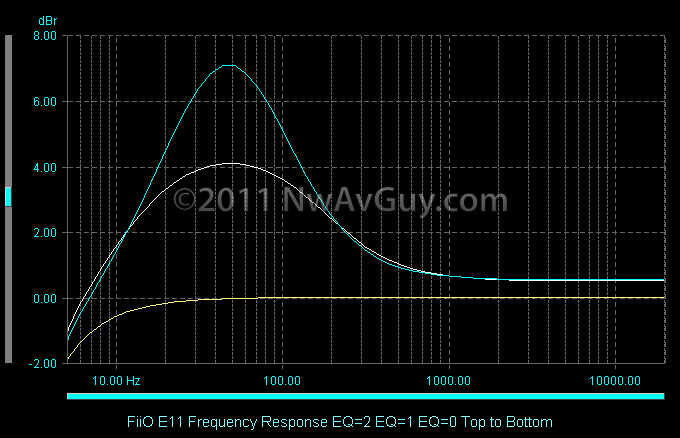
SQUARE WAVE PERFORMANCE: The high speed scope shot below shows the E11 into Sennheiser CX300 headphones with 0.01 uF of added capacitance to simulate more difficult headphones. As was observed with the same very fast AD8397 op amp in the Mini3, there’s some ringing and signs of instability. What’s different is the Mini3 show even more ringing without any added capacitance into the same headphones. So the E11 is at least better behaved than the Mini3. The thick “fuzzy” horizontal portion of the waveform is RF noise from the DC-DC converter. The second graph shows the O2 on the same test with the same load. Note the lack of ringing, and the lack of “fuzz” as the O2 doesn’t use a DC-DC converter and uses a 2 stage design with properly compensated op amps better suited to audio use:

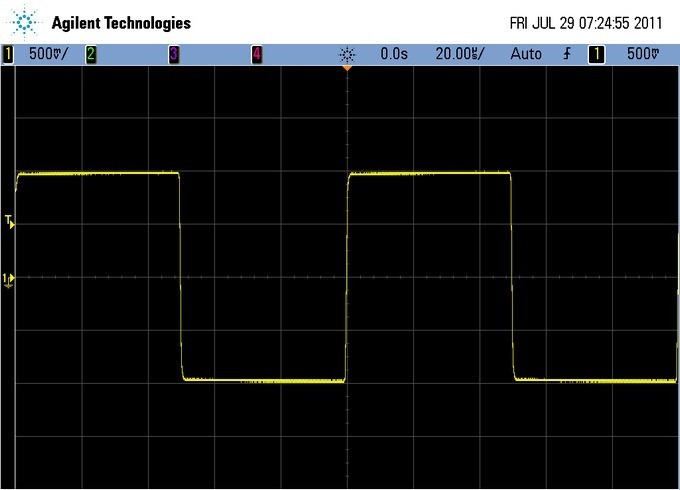
SLEW RATE: As shown below, the E11 slews 4.5 volts in 710 nS which is a 6.6 V/uS slew rate. This is many times what’s required for any audio signal the amp will ever encounter. It’s worth noting it’s a bit slower than the Mini3’s measured 10.7 V/uS which is further evidence FiiO wisely applied some additional compensation, RF input filtering, or otherwise decided not run the AD8397 “wide open” as AMB chose to. The O2 has a 3.6 V/uS slew rate which is still well in excess of what’s required any recorded music for the output voltage the amp is capable of:
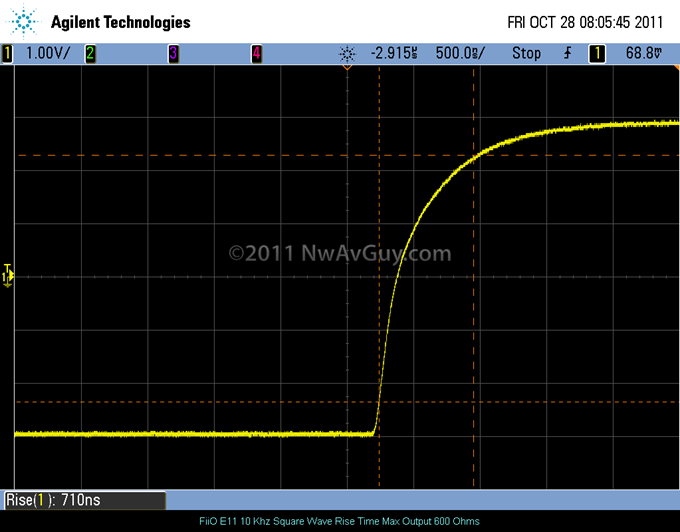
DC-DC CONVERTER NOISE: Here’s a zoomed-in view of the “fuzz” seen on the square wave response above. The scope measurement shows it has a frequency of 96 Mhz and it’s likely the DC-DC converter which is probably designed to run somewhere around a nominal 100 Mhz. You can also see it’s about 15 mV peak-to-peak or about 5 mV RMS. That’s only –43 dBu. Obviously nobody can hear 100 Mhz but if it were in the audio band it would be plainly audible. It can also be troublesome for FCC and/or CE approval for RF emissions: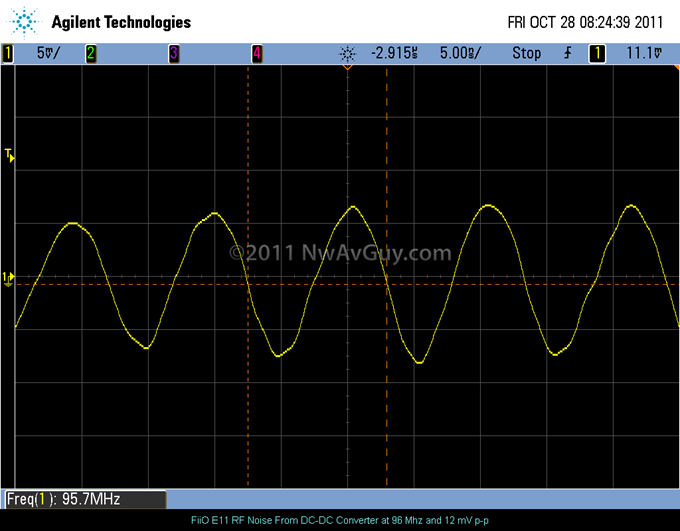
CLIPPING PERFORMANCE: The E11 clipped cleanly and symmetrically at a bit over 8 Vp-p into 600 ohms. This shows the internal DC-DC power supply is likely around 9 volts (accounting for the inability of the AD8397 to swing all the way to the rails). The 100 Mhz “fuzz” is plainly visible on the entire waveform:
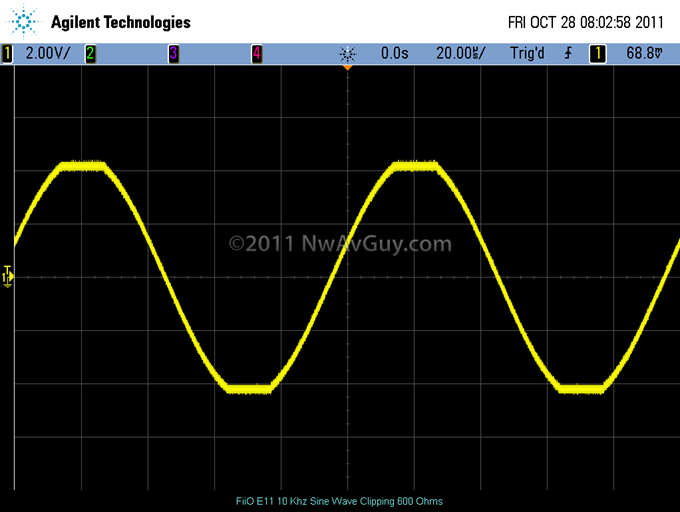
THIRD CHANNEL VIRTUAL GROUND: The large number of distortion products created by just a single sine wave in each channel is something the E11 shares with the Mini3. In the E11 the Interchannel IMD is much lower in level but the total sum of all the distortion could still be audible—especially with the complex interactions of real stereo music fighting between the channels via the shared OPA690 ground channel. The E11 likely uses a single ground and perhaps a better ground layout (the Mini3 uses a poor ground PCB layout and isolates the input and output grounds) but it still suffers from the shared OPA690—an op amp not very well suited to the task. As explained at the start of the Tech Section, the E11 would have been much better as a two channel amp with a DC-DC converter that produced two supply rails instead of just one. See Virtual Grounds & 3 Channel Amps and the original Mini3 review for more.
TECH COMMENTS: The E11, in short, measured better than I thought it would although, just like the Min3, it failed to deliver its claimed power output. When driving low impedance headphones its true clipping point is a bit hard to determine likely due to either an undersized DC-DC converter and/or wimpy power supply capacitors. Even being generous and using the 1% THD points with only 15 minutes run time on a fully charged battery it it still fell significantly short of the claimed output. It’s best to use 16 ohm headphones that need no more than 1 Vrms and 32 ohms headphones that need no more than 1.7 Vrms. I’m also concerned about the very large number of Interchannel IMD distortion products created by the third channel as discussed in the paragraph above. It’s interesting the E11 performed significantly better in nearly every area than the Mini3 despite both using a 9 volt power supply, similar 3 channel design, and the same op amps. As mentioned earlier, it’s more evidence implementation is more important than the components used.


